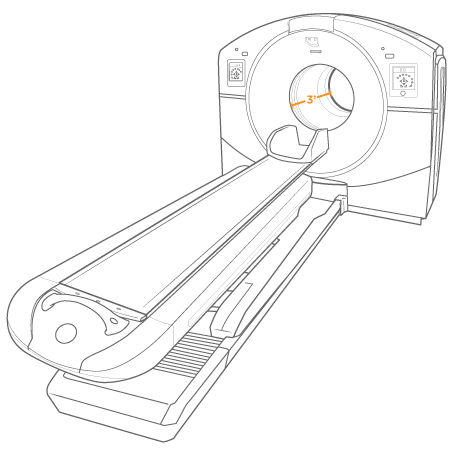This information will help you get ready for your positron emission tomography (PET) computed tomography (CT) scan with NaFl tracer at MSK.
About your PET-CT with NaFl tracer
A PET-CT scan is an imaging procedure that is used to:
- Find cancer cells.
- Plan your treatment.
- See how your treatment is working.
You’ll have a CT scan with a low dose of radiation at the same time as your PET scan. CT scans take a fast series of X-ray pictures. They’re combined with your PET scan to create pictures of your soft tissues and bones.
You may also be scheduled for a diagnostic CT at the same time as your PET-CT. A diagnostic CT lets your healthcare provider learn more about your tissues, bones, and blood vessels. Ask your healthcare provider for the resource Computed Tomography (CT) Scan to help you get ready.
Tracer
You’ll get a radioactive medication called a tracer before your PET-CT. The tracer is attached to a substance your cells and tissues use. Cancer cells do not use the substance the same way as healthy cells. The radioactive part of the tracer lets your healthcare provider see how your cells use the substance. This helps them find cancer cells.
The tracer doesn’t stay in your body long. It leaves your body mainly through your urine.
You will get the tracer through an intravenous (IV) line we place in your arm or hand. If you have a central venous catheter (CVC), we will only use it for the tracer if we cannot place an IV for any reason. This is because the PET-CT images are clearer if you get the tracer through an IV.
Your PET-CT will use NaFl as the tracer.
Getting ready for your PET-CT with NaFl tracer
Breastfeeding and pregnancy
Tell your healthcare provider if you’re pregnant or breastfeeding. This will help them plan your care.
Take devices off your skin
You may wear certain devices on your skin. Before your scan or procedure, some device makers recommend you take off your:
- Continuous glucose monitor (CGM)
- Insulin pump
Talk with your healthcare provider about scheduling your appointment closer to the date you need to change your device. Make sure you have an extra device with you to put on after your scan or procedure.
You may not be sure how to manage your glucose while your device is off. If so, before your appointment, talk with the healthcare provider who manages your diabetes care.
Remove jewelry
Jewelry can make the images from your scan harder to read. Certain metals can also heat up and cause burns during your scan. Tell a member of your care team if you cannot remove your jewelry before the day of your scan.
What to do the day before your PET-CT with NaFl tracer
If you’re getting anesthesia (A-nes-THEE-zhuh), read the “For people getting anesthesia” section at the end of this resource. Anesthesia is medicine to numb you or make you sleep.
What to do the day of your PET-CT with NaFl tracer
What to expect when you arrive
Many staff members will ask you to say and spell your name and birth date. This is for your safety. People with the same or similar names may be having a procedure on the same day. Once you’re in the department, you’ll fill out a brief questionnaire.
Your care team will inject the tracer into your vein. You’ll wait 60 minutes for your body to absorb the tracer. How long this takes will depend on the area of your body being scanned.
Try to relax and limit your movement during this time. You can sleep, read, listen to music, or watch videos while you’re waiting. Ask for a blanket if you feel cold.
Your care team will ask you to urinate (pee) just before your scan.
During your PET-CT with NaFl tracer
When it’s time for your scan, your technologist will bring you to the scanning room. They will help you onto the scanning table.
The machine looks like a large doughnut with a hole in the middle (see figure 1). This is the scanning ring (scanner). The scanner is about 3 feet (1 meter) deep.

Once you’re on the scanning table, the table will move slowly through the scanning ring. You must lie very still until your scan is done. This can take 30 to 45 minutes, depending on the type of scan you’re having.
If you’re also scheduled for a diagnostic CT scan, you’ll get a contrast infusion through your IV or CVC. An infusion is when medicine is slowly put into your bloodstream. This will happen after your technologist takes the first series of pictures.
To learn more, read Computed Tomography (CT) Scan.
What to do after your PET-CT with NaFl tracer
You may leave as soon as your scan is done, unless you have other tests or procedures scheduled. You’ll get a card stating that you had a test done with a radioactive tracer and your test date. Keep this card with you because some security equipment can find radioactivity until it leaves your body. This should take less than a day.
It’s important that you limit close contact with babies or pregnant people as much as possible for 12 hours after your scan. Otherwise, you can go about your day as usual, including having visits with your healthcare providers.
If you’re breastfeeding, stop breastfeeding for 12 hours after your scan. You can still express (pump) milk during that time.
You can then either:
- Throw away the pumped milk.
- Store the pumped milk for 12 hours. After that, it’s safe to give to the baby.
During this time, you can feed the baby with formula or milk that was expressed before the scan. You can restart breastfeeding 12 hours after your scan.
Remember to stay hydrated after your scan. Drink water and other fluids throughout the rest of the day to help remove the tracer from your body. You can go back to your normal diet right away, unless you’re given other instructions.
When to call your care team
Watch the insertion site (where the IV went into your body) for 48 hours (2 days) after your scan. Call your care team if you notice any changes in the area, such as:
- Pain or a burning feeling
- Redness or other skin color changes
- Swelling
- Broken skin
- Blisters or liquid draining
- Numbness, tingling, or other changes in sensation (feeling)
- Warm or hot skin
You do not need to do this if you got the tracer through your CVC.
Getting your results
A radiologist will read your scan and send your results to your doctor. If your PET-CT was done to find cancer cells, your doctor should have your results in 2 business days. Ask your doctor how they will share your results with you. If your PET-CT was done to plan your treatment, your doctor will use the images to plan your care.
Contact information
For people getting anesthesiaFollow these instructions if you are getting anesthesia during your PET-CT. What to do the day before your PET-CTArrange for someone to take you homeYou must have a responsible care partner take you home after your procedure. A responsible care partner is someone who can help you get home safely. They should be able to contact your care team if they have any concerns. Make sure to plan this before the day of your procedure. If you don’t have a responsible care partner to take you home, call one of the agencies below. They’ll send someone to go home with you. There’s a charge for this service, and you’ll need to provide transportation. It’s OK to use a taxi or car service, but you still need a responsible care partner with you.
Instructions for eatingStop eating at midnight (12 a.m.) the night before your procedure. This includes hard candy and gum. What to do the day of your PET-CTInstructions for drinkingBetween midnight (12 a.m.) and 2 hours before your arrival time, only drink the liquids on the list below. Do not eat or drink anything else. Stop drinking 2 hours before your arrival time.
If you have diabetes, pay attention to the amount of sugar in your drinks. It will be easier to control your blood sugar levels if you include sugar-free, low-sugar, or no added sugar versions of these drinks. It’s helpful to stay hydrated before procedures, so drink if you are thirsty. Do not drink more than you need. You will get intravenous (IV) fluids during your procedure. Stop drinking 2 hours before your arrival time. This includes water. |
